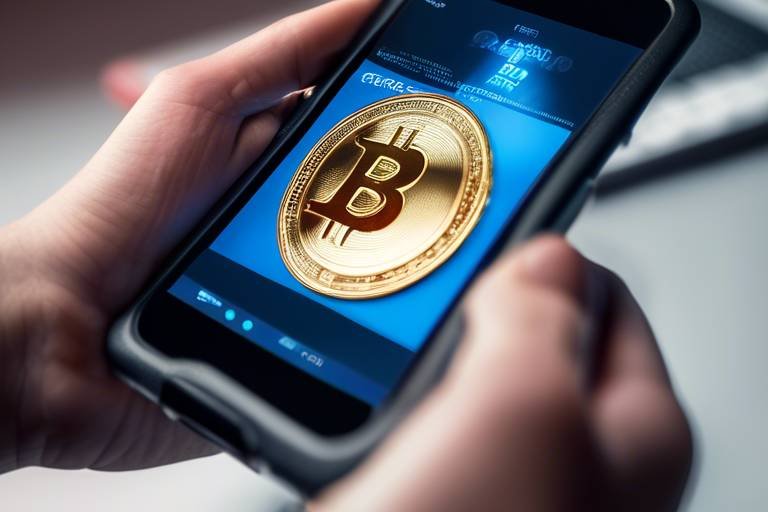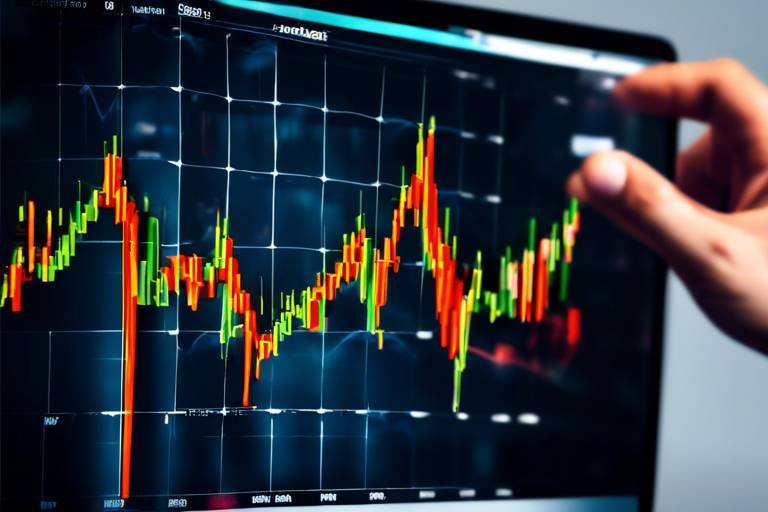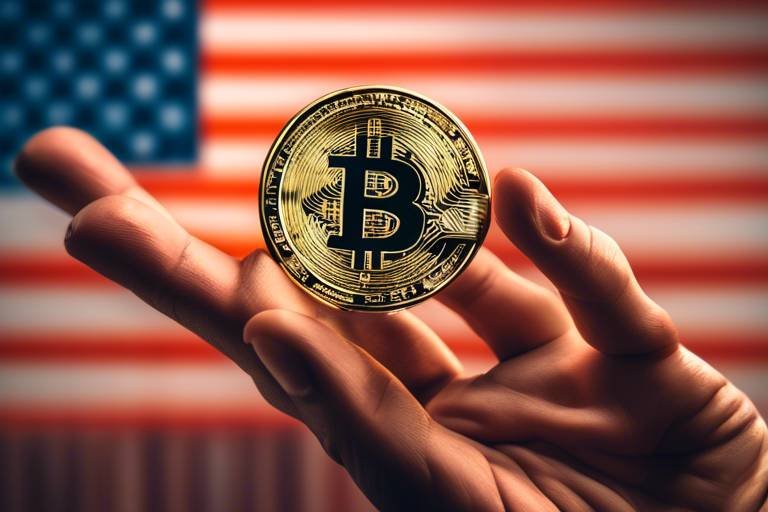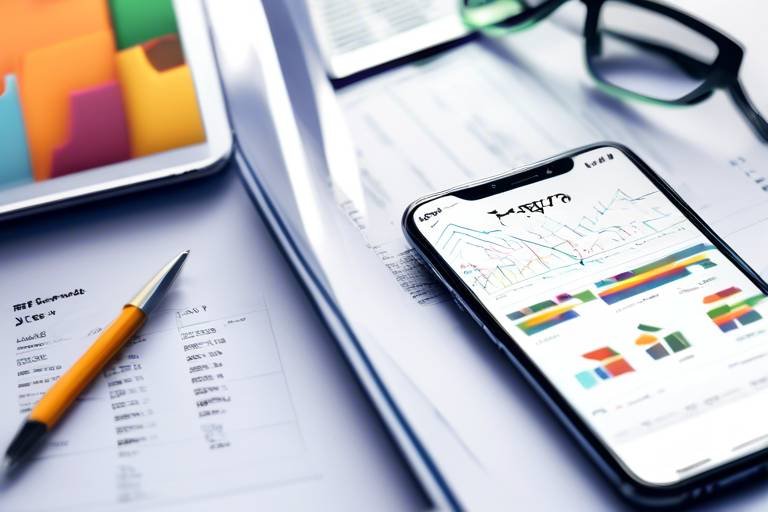Understanding the Effects of Technological Disruption on Markets
In today's fast-paced world, technological disruption is not just a buzzword; it’s a reality that reshapes the very fabric of industries and markets. Imagine walking into a store and finding that the products you once knew are now replaced by innovative alternatives that cater to your every need. This phenomenon is not merely about new gadgets or software; it’s about a fundamental shift in how businesses operate and how consumers engage with them. As we delve deeper into this topic, we will uncover the intricate ways in which technological disruption influences market dynamics, consumer behavior, and the strategies businesses must adopt to thrive in this ever-evolving landscape.
So, what exactly is technological disruption? At its core, it refers to innovations that significantly alter existing industries or markets. Unlike gradual changes that evolve over time, disruptions occur suddenly and often catch established businesses off-guard. Think of it like an earthquake shaking the ground beneath your feet; you might not see it coming, but its impact is undeniable. Key characteristics of technological disruption include:
- Speed: Disruptive innovations tend to emerge rapidly, often outpacing traditional business models.
- Accessibility: New technologies often lower barriers to entry, allowing new players to enter the market.
- Consumer-Centric: Disruption often arises from changing consumer needs and behaviors.
These forces are driven by advancements in technology, such as artificial intelligence, blockchain, and the Internet of Things (IoT), which are transforming various sectors from retail to healthcare. As we explore the impact of these changes, it becomes clear that businesses must either adapt or risk becoming obsolete.
As technology evolves, so does consumer behavior. Today's consumers are more informed and connected than ever before, thanks to digital advancements. Imagine shopping online at midnight, comparing prices, reading reviews, and making purchases—all from the comfort of your couch. This shift has fundamentally changed purchasing decisions and customer expectations. Consumers now demand:
- Convenience: The ability to shop anytime, anywhere.
- Personalization: Tailored experiences that cater to individual preferences.
- Transparency: Clear information about products and services.
These evolving expectations have transformed the overall shopping experience, both online and offline. Retailers must now find innovative ways to engage customers, whether through interactive websites, mobile apps, or in-store technology that enhances the shopping journey.
For established companies, adapting to technological disruption can feel like trying to steer a massive ship in a storm. The challenges they face are numerous and often daunting. Common hurdles include:
- Resistance to Change: Employees and management may be reluctant to embrace new technologies.
- Legacy Systems: Outdated technology can hinder innovation and slow down processes.
- Need for Digital Transformation: Many companies struggle to pivot their business models to incorporate digital strategies.
These challenges can lead to significant setbacks, but they also present opportunities for growth and revitalization if addressed effectively.
On the flip side, startups often thrive in disrupted markets. They possess unique advantages that allow them to capitalize on new technologies and shifting consumer demands. Their agility enables them to pivot quickly, embrace innovation, and create solutions that resonate with today’s consumers. Startups can leverage:
- New Technologies: Utilizing cutting-edge tools to offer unique products or services.
- Market Gaps: Identifying and filling voids left by traditional businesses.
- Customer-Centric Approaches: Focusing on user experience and feedback to drive product development.
This nimbleness often leads to disruptive innovations that challenge the status quo and redefine market standards.
Real-world examples provide valuable insights into the effects of technological disruption. Consider the case of Netflix, which revolutionized the way we consume media. By shifting from DVD rentals to streaming services, Netflix not only adapted to changing consumer preferences but also set a new industry standard. Conversely, traditional video rental stores like Blockbuster struggled to keep up and ultimately faced extinction. Such case studies illustrate both successful adaptations and failures in the face of change, offering lessons for businesses navigating this turbulent landscape.
To effectively navigate disruption, businesses must develop robust strategies. Embracing innovation is key, but it’s equally important to foster a culture of adaptability within the organization. Companies should:
- Invest in Training: Equip employees with the skills necessary to adapt to new technologies.
- Leverage Data Analytics: Use data to inform decision-making and anticipate market trends.
- Encourage Collaboration: Promote teamwork across departments to drive innovative solutions.
These approaches can help businesses remain relevant and competitive in a rapidly changing market.
Government policies and regulations play a crucial role in shaping the landscape of technological disruption. Regulatory frameworks can either facilitate or hinder innovation, impacting how businesses operate. For instance, supportive policies can encourage investment in new technologies, while restrictive regulations may stifle growth. It’s essential for governments to strike a balance that fosters innovation while ensuring consumer protection and fair competition.
Looking ahead, the future trajectory of markets amid ongoing technological advancements is both exciting and uncertain. Potential trends include the rise of artificial intelligence in decision-making, the increasing importance of sustainability, and the continuous evolution of consumer preferences. Businesses must stay vigilant and adaptable, ready to embrace emerging technologies and changing market dynamics. The ability to anticipate these shifts will be crucial for success in a disrupted world.
Q1: What is technological disruption?
A1: Technological disruption refers to innovations that significantly alter existing industries or markets, often emerging rapidly and catching established businesses off-guard.
Q2: How does technological disruption affect consumer behavior?
A2: As technology evolves, consumers become more informed and connected, leading to changes in purchasing decisions and heightened expectations for convenience, personalization, and transparency.
Q3: What challenges do traditional businesses face in adapting to disruption?
A3: Common challenges include resistance to change, legacy systems, and the need for digital transformation, which can hinder innovation and growth.
Q4: How can startups leverage disruption to their advantage?
A4: Startups can thrive by being agile, embracing new technologies, and focusing on customer-centric approaches that address emerging consumer demands.

The Nature of Technological Disruption
Technological disruption is like a whirlwind that sweeps through industries, leaving behind a transformed landscape. It refers to innovations that significantly alter how markets operate, often rendering established practices obsolete. Unlike gradual changes that evolve slowly over time, disruptions can occur suddenly and dramatically, catching many off guard. Think of it as a seismic shift in the ground beneath your feet; one moment everything seems stable, and the next, you're navigating a new terrain.
At the heart of technological disruption are several key characteristics that set it apart from traditional market evolution. Firstly, it tends to be driven by groundbreaking technologies that challenge the status quo. For example, the rise of smartphones didn’t just change how we communicate; it revolutionized entire industries, from retail to entertainment. Secondly, disruption often creates new market leaders while pushing established players to the sidelines. Companies that fail to adapt can quickly find themselves outdated, much like a once-popular cassette tape player in the age of streaming music.
Several forces fuel these transformative shifts. Among them are:
- Rapid Technological Advancements: Innovations in AI, machine learning, and automation are reshaping industries at an unprecedented pace.
- Changing Consumer Expectations: Today's consumers demand more personalized, convenient, and efficient experiences, pushing companies to adapt or risk losing market share.
- Globalization: The interconnectedness of markets means that disruptions can have far-reaching impacts, affecting businesses across the globe.
To further illustrate the nature of technological disruption, consider the impact of ride-sharing apps like Uber. They didn’t just introduce a new way to hail a cab; they transformed public transportation by challenging regulations, altering consumer behavior, and creating a new economy of gig workers. This example highlights how disruption is not merely about new technologies; it's about the ripple effects that these innovations create across entire ecosystems.
In summary, understanding the nature of technological disruption is crucial for businesses and consumers alike. It’s not just a buzzword; it’s a reality that shapes our world. Companies that recognize the signs of impending disruption can position themselves to thrive, while those that ignore it risk being swept away in the tide of change.
- What is technological disruption? Technological disruption refers to innovations that significantly alter industries or markets, often rendering established practices obsolete.
- How does technological disruption differ from gradual change? Disruptions occur suddenly and dramatically, while gradual changes evolve slowly over time.
- What are some examples of technological disruption? Examples include the rise of smartphones, ride-sharing apps, and the impact of e-commerce on traditional retail.

Impact on Consumer Behavior
In the whirlwind of technological advancement, consumer behavior is like a chameleon, constantly adapting to its surroundings. The days of traditional shopping, where customers would leisurely stroll through brick-and-mortar stores, are fading fast. Now, with a few swipes on a smartphone, consumers can access a universe of products and services right at their fingertips. This shift is not just about convenience; it’s about a profound transformation in how we think, feel, and act as consumers.
So, what exactly is driving this change? First and foremost, the rise of digital platforms has fundamentally altered the shopping landscape. E-commerce giants like Amazon have set a new standard for customer expectations. Today’s consumers demand not only a vast selection of products but also lightning-fast delivery times, personalized recommendations, and seamless return policies. The expectation of instant gratification has become the norm, and businesses that fail to meet these demands risk losing their customer base.
Moreover, social media plays a pivotal role in shaping consumer behavior. Platforms like Instagram and TikTok have turned into powerful marketing tools, influencing purchasing decisions through visually appealing content and influencer endorsements. When consumers see their favorite celebrities using a product, it creates a sense of trust and desirability. This phenomenon can lead to what we call the “bandwagon effect,” where individuals feel compelled to join in on the latest trends, often leading to impulsive buying decisions.
Another critical factor is the shift towards sustainability. More consumers are becoming environmentally conscious, which influences their buying choices. They are increasingly inclined to support brands that prioritize ethical practices and sustainability. According to recent studies, a significant percentage of consumers are willing to pay more for products from companies that are committed to reducing their carbon footprint. This change indicates a broader trend where consumers are not just looking for quality and price; they are also considering the impact of their purchases on the planet.
To illustrate these shifts, consider the following table that summarizes key changes in consumer behavior:
| Aspect | Traditional Behavior | Modern Behavior |
|---|---|---|
| Shopping Method | In-store visits | Online shopping |
| Decision Influencers | Word of mouth | Social media and influencers |
| Purchase Drivers | Quality and price | Sustainability and ethical practices |
Additionally, the rise of mobile technology has made it easier for consumers to research products before making a purchase. With just a few taps, shoppers can compare prices, read reviews, and even see how a product looks in their home through augmented reality apps. This access to information empowers consumers, making them more informed and confident in their choices. They are no longer passive recipients of marketing messages; they actively seek out information that aligns with their values and preferences.
However, this evolution in consumer behavior also presents challenges for businesses. Companies must now invest in understanding their customers’ preferences and behaviors on a deeper level. Data analytics tools are becoming essential for tracking consumer trends and tailoring marketing strategies accordingly. Brands that can harness this data to create personalized experiences will likely stand out in the crowded marketplace.
In conclusion, the impact of technological disruption on consumer behavior is vast and multifaceted. As we move forward, businesses must remain agile and responsive to these changes. The key to thriving in this new landscape lies in understanding the consumer's evolving needs and desires. After all, in this digital age, it’s not just about selling a product; it’s about creating an experience that resonates with the modern consumer.
- How has technology changed shopping habits? Technology has shifted shopping from in-store experiences to online platforms, emphasizing convenience and speed.
- What role does social media play in consumer behavior? Social media influences purchasing decisions through marketing and endorsements, shaping trends and consumer preferences.
- Why are consumers more focused on sustainability now? Increased awareness of environmental issues has led consumers to prefer brands that demonstrate ethical practices and sustainability.

Challenges for Traditional Businesses
In today's fast-paced world, traditional businesses are finding themselves at a crossroads. The advent of technology has not just nudged the market; it has practically shaken it to its core. This technological disruption presents a plethora of challenges that can feel overwhelming. Many established companies, once the giants of their industries, are now struggling to keep pace with the rapid changes. But what exactly are these challenges, and why do they pose such a significant threat?
One of the most pressing issues is the resistance to change. For many traditional businesses, the existing systems, processes, and cultures are deeply ingrained. Employees may be hesitant to adopt new technologies, fearing that it could jeopardize their jobs or disrupt their comfortable routines. This reluctance can create a significant barrier to innovation. Think of it as trying to steer a massive ship; it takes time and effort to change its course, even when the winds of change are howling.
Moreover, the presence of legacy systems complicates matters further. Many established companies rely on outdated technology that is often incompatible with the latest advancements. These legacy systems can be costly to maintain and upgrade, leading to a situation where businesses are stuck in a cycle of inefficiency. Imagine trying to fit a square peg into a round hole; it’s frustrating and ultimately unproductive.
Another challenge is the urgent need for digital transformation. As consumer behavior shifts towards online platforms, traditional businesses must adapt or risk becoming obsolete. This transformation isn't just about having a website; it involves rethinking entire business models. Companies must embrace e-commerce, social media marketing, and data analytics to stay relevant. The pressure to innovate can feel like running on a treadmill set to high speed—if you don’t keep up, you’ll fall behind.
Additionally, traditional businesses often face fierce competition from agile startups that are unencumbered by the weight of history. These nimble newcomers can pivot quickly, responding to market demands and consumer preferences with ease. They leverage technology in ways that established companies may struggle to replicate. This competitive landscape can feel like a race where the traditional players are stuck at the starting line, while the startups zoom ahead.
Lastly, there is the challenge of customer expectations. Today's consumers are tech-savvy and expect seamless, personalized experiences. They want instant gratification and quick responses. Traditional businesses, with their slower decision-making processes and outdated customer service models, may find it difficult to meet these rising expectations. It’s as if they are trying to serve a gourmet meal in a fast-food environment; the mismatch can lead to dissatisfaction and lost sales.
In summary, the challenges for traditional businesses in the face of technological disruption are multifaceted. From resistance to change and legacy systems to the need for digital transformation, competition from agile startups, and evolving customer expectations, the stakes have never been higher. However, acknowledging these challenges is the first step towards overcoming them. By embracing change and fostering a culture of innovation, traditional businesses can navigate this tumultuous landscape and emerge stronger than ever.
- What is technological disruption? Technological disruption refers to innovations that significantly alter industries or markets, often leading to the decline of established companies.
- Why do traditional businesses struggle with change? Many traditional businesses face resistance to change due to ingrained processes, legacy systems, and a lack of digital transformation.
- How can traditional businesses adapt to technological disruption? They can adapt by embracing innovation, investing in new technologies, and fostering a culture that encourages flexibility and responsiveness.
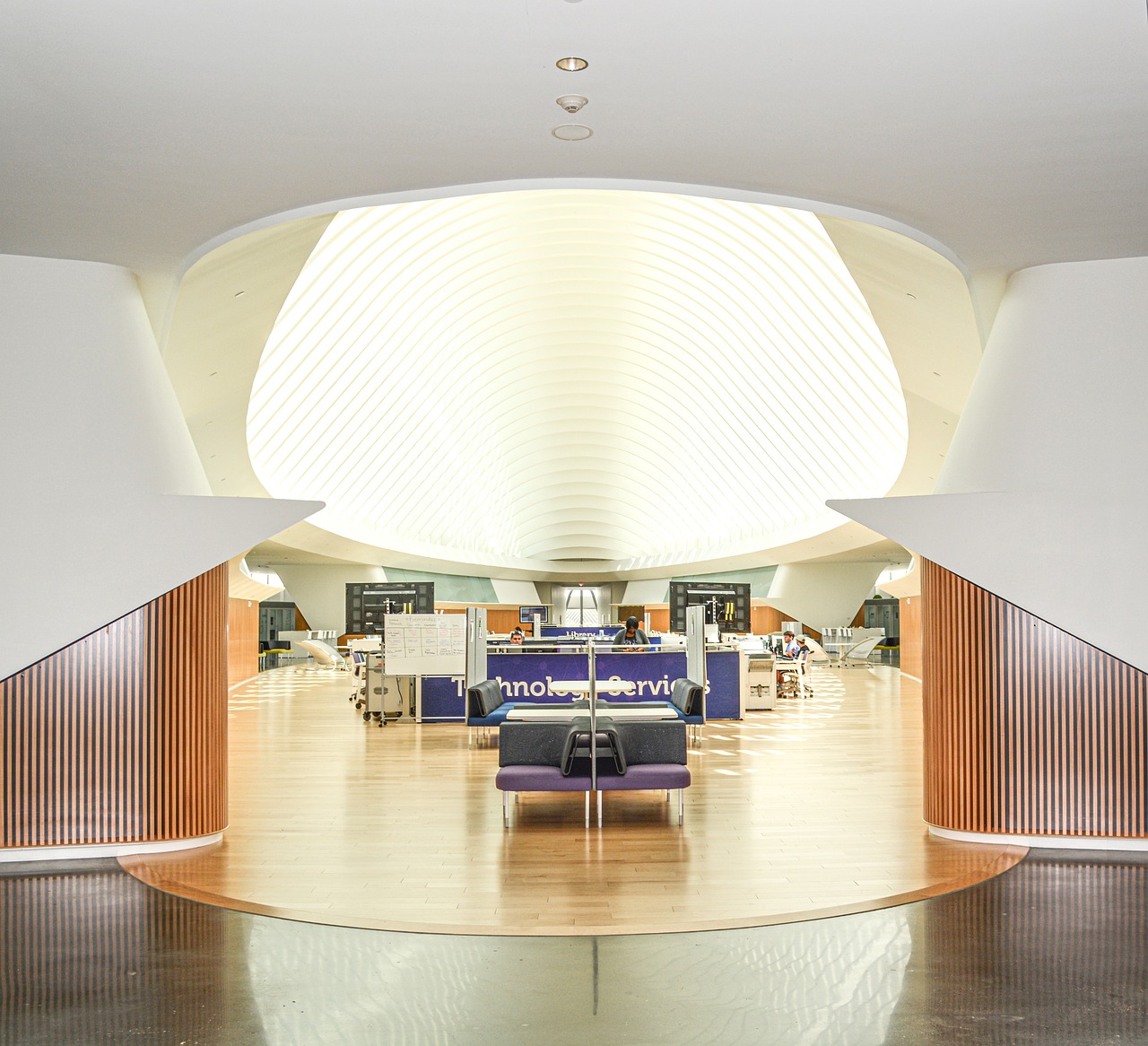
Opportunities for Startups
In today's fast-paced world, startups are like nimble ships sailing through turbulent waters, while established companies often resemble massive oil tankers that struggle to change course. The technological disruption sweeping across various industries creates a fertile ground for innovation, and startups are uniquely positioned to seize these opportunities. With their inherent agility, they can adapt quickly to market changes, leverage cutting-edge technologies, and meet the evolving demands of consumers. This section delves into the myriad advantages that startups enjoy in disrupted markets, illustrating how they can thrive where traditional businesses might falter.
One of the most significant opportunities for startups lies in their ability to embrace innovation without the burden of legacy systems. Unlike larger corporations that may be tied down by outdated technology and processes, startups can build their operations from the ground up using the latest tools and platforms. This allows them to create products and services that are not only innovative but also tailored to meet the specific needs of their target audience. For instance, a startup in the fintech sector can develop an app that simplifies banking for millennials, leveraging APIs and cloud computing to deliver a seamless user experience.
Moreover, startups often possess a unique understanding of emerging consumer trends. They are typically founded by individuals who are deeply passionate about their fields, allowing them to identify gaps in the market that larger companies might overlook. This grassroots knowledge enables startups to create solutions that resonate with consumers on a personal level. For example, a startup that focuses on sustainable fashion can tap into the growing demand for eco-friendly products by offering a line of clothing made from recycled materials, appealing to environmentally conscious shoppers.
Another advantage that startups have is their ability to pivot quickly. In a world where change is the only constant, the capacity to adapt is crucial. Startups can test new ideas, gather feedback, and iterate their offerings much faster than their larger counterparts. This flexibility allows them to stay ahead of the curve, responding to consumer feedback and market trends in real-time. Take the case of a tech startup that initially launched a social media platform but pivoted to focus on virtual events when the pandemic hit. By recognizing the shift in consumer behavior, they not only survived but thrived during a challenging time.
Furthermore, the rise of digital marketing and social media has leveled the playing field for startups. They can reach a global audience without the massive budgets that traditional advertising requires. With platforms like Instagram, TikTok, and Facebook, startups can build their brand and engage with customers directly, often going viral with creative campaigns. This democratization of marketing means that a small startup can compete with industry giants, provided they have a compelling story and an authentic connection with their audience.
To encapsulate the opportunities for startups in a disrupted market, consider the following key points:
- Agility: Startups can adapt quickly to changes in technology and consumer behavior.
- Innovation: They can leverage the latest technologies to create unique solutions.
- Market Insight: Founders often have a deep understanding of emerging trends and consumer needs.
- Pivotal Flexibility: Startups can easily pivot their business models based on market demands.
- Cost-Effective Marketing: Digital platforms provide cost-effective ways to reach consumers.
In conclusion, the landscape of technological disruption presents a treasure trove of opportunities for startups. By harnessing their strengths and staying attuned to market dynamics, these agile innovators can carve out a niche for themselves, challenge the status quo, and ultimately drive significant change in their respective industries. The future belongs to those who dare to dream big, innovate relentlessly, and adapt swiftly to the ever-evolving market landscape.
- What is the main advantage of startups in a disrupted market?
Startups can adapt quickly to changes, leverage new technologies, and respond to consumer needs more effectively than established companies. - How can startups effectively market themselves?
By utilizing digital marketing strategies and social media platforms, startups can reach a wide audience without large budgets. - What role does innovation play for startups?
Innovation allows startups to create unique products or services that meet the specific demands of their target market.

Case Studies of Disruption
Case studies are like treasure maps that lead us to the heart of technological disruption, revealing both the triumphs and tribulations faced by various industries. Let's dive into a couple of compelling examples that illustrate how companies have navigated the rocky waters of change.
One of the most iconic case studies is that of Blockbuster and Netflix. Once a giant in the movie rental industry, Blockbuster failed to adapt to the digital revolution. Despite having the opportunity to purchase Netflix in its early days, Blockbuster clung to its traditional business model, which revolved around physical stores and late fees. On the flip side, Netflix embraced the digital landscape, transitioning from DVD rentals to streaming services. This shift not only redefined how we consume media but also led to the eventual downfall of Blockbuster, which filed for bankruptcy in 2010. This case starkly highlights the importance of adaptability and foresight in the face of disruptive technology.
Another fascinating example is Uber, which disrupted the traditional taxi industry. By leveraging a mobile app and GPS technology, Uber transformed how people think about transportation. It offered a convenient, user-friendly alternative to traditional taxi services, which often involved long waits and unreliable service. The ride-hailing app not only changed consumer expectations around convenience and pricing but also sparked a global conversation about regulation and the gig economy. Traditional taxi companies struggled to keep up, facing challenges such as regulatory hurdles and public backlash against their outdated practices. Uber's success illustrates how embracing innovation can lead to significant market disruption.
In the retail sector, we can't overlook the impact of Amazon. Originally an online bookstore, Amazon has grown into a colossal marketplace that has redefined shopping. Its commitment to customer experience, fast shipping, and an extensive product range has reshaped consumer behavior. Traditional retailers have had to rethink their strategies, often resulting in store closures and shifts toward e-commerce. A notable example is Sears, which once dominated the retail landscape but struggled to compete with Amazon's model. By failing to innovate and adapt to changing consumer preferences, Sears filed for bankruptcy in 2018, serving as a cautionary tale for businesses that resist change.
These case studies illustrate that the ability to adapt to technological disruption is not just a nice-to-have; it's a necessity for survival. Companies that embrace change and leverage new technologies often emerge stronger, while those that resist may find themselves left behind. As we continue to explore the effects of disruption on various markets, it becomes clear that the only constant is change itself.
- What is technological disruption? Technological disruption refers to innovations that significantly alter industries or markets, often leading to the decline of established businesses that fail to adapt.
- How can businesses prepare for disruption? Businesses can prepare for disruption by fostering a culture of innovation, embracing new technologies, and staying attuned to changing consumer behaviors.
- What are some examples of companies that have successfully adapted to disruption? Companies like Netflix and Amazon have successfully adapted to technological disruption by leveraging new technologies and changing consumer expectations.
- Why do some companies fail in the face of disruption? Companies often fail due to resistance to change, reliance on outdated business models, and a lack of understanding of emerging technologies.

Strategies for Adaptation
In a world where technological disruption is the new norm, businesses must not only adapt but also thrive amidst the chaos. The question is, how can companies position themselves to not just survive but flourish in such an unpredictable environment? The answer lies in a multifaceted approach that embraces innovation, fosters a culture of adaptability, and leverages data analytics.
First and foremost, embracing innovation is crucial. This doesn’t mean simply jumping on the latest tech bandwagon; rather, it involves a deep understanding of how new technologies can enhance existing processes or create entirely new business models. Companies should encourage their teams to think creatively and explore cutting-edge solutions. This could be anything from adopting artificial intelligence to streamline operations, to utilizing augmented reality to enhance customer experiences. By fostering a culture that celebrates experimentation, businesses can unlock new avenues for growth.
Next, organizations must cultivate a culture of adaptability. This means creating an environment where change is not only accepted but expected. Employees should feel empowered to voice their ideas and concerns about new technologies and processes. Regular training sessions can help staff stay updated on the latest trends and tools, ensuring that everyone is equipped to handle changes as they arise. When employees are adaptable, the entire organization can pivot more effectively in response to market shifts.
Another key strategy is to leverage data analytics. In today’s data-driven world, information is king. Companies that harness data can gain valuable insights into consumer behavior, market trends, and operational efficiencies. By analyzing this data, businesses can make informed decisions that align with their strategic goals. For instance, a retail company might use data analytics to optimize its inventory management, ensuring that it meets customer demand without overstocking. This proactive approach not only saves costs but also enhances customer satisfaction.
To illustrate these strategies, consider the following table that outlines how various companies have successfully adapted to technological disruption:
| Company | Strategy Employed | Outcome |
|---|---|---|
| Netflix | Embraced streaming technology | Transformed from DVD rentals to a leading streaming service |
| Adobe | Shifted to a subscription model | Increased customer retention and revenue stability |
| Amazon | Utilized data analytics for personalized marketing | Enhanced customer experience and increased sales |
In conclusion, the strategies for adaptation in the face of technological disruption are not just about keeping up; they are about leading the charge. By embracing innovation, cultivating adaptability, and leveraging data analytics, businesses can transform challenges into opportunities. It’s not merely a matter of responding to change; it’s about anticipating it and being prepared to capitalize on it.
- What is technological disruption? Technological disruption refers to innovations that significantly alter industries or markets, often displacing established businesses and creating new ones.
- How can companies foster a culture of adaptability? Companies can foster adaptability by encouraging open communication, providing regular training, and empowering employees to take initiative in the face of change.
- Why is data analytics important for businesses? Data analytics helps businesses make informed decisions by providing insights into consumer behavior, market trends, and operational efficiencies.
- What are some examples of companies that have successfully adapted to disruption? Companies like Netflix, Adobe, and Amazon are prime examples of businesses that have successfully navigated technological disruption through strategic innovation and adaptability.

The Role of Government and Regulation
In the rapidly evolving landscape of technological disruption, the role of government and regulation is more crucial than ever. As new technologies emerge, they often challenge existing laws and frameworks, necessitating a reevaluation of how governments approach regulation. The balance between fostering innovation and ensuring consumer protection is a delicate one. Governments must navigate this terrain carefully, as overly stringent regulations can stifle creativity, while too lenient approaches may expose consumers to risks.
One of the primary functions of government in the context of technological disruption is to create an environment that encourages innovation. This can be achieved through various means, such as tax incentives for research and development, grants for startups, and the establishment of innovation hubs. For instance, countries like Singapore and Israel have implemented policies that support tech entrepreneurs, resulting in thriving ecosystems that attract global talent and investment. However, the challenge lies in ensuring that these policies effectively address the needs of both businesses and consumers.
Moreover, regulations must evolve in tandem with technology. Consider the rise of artificial intelligence and machine learning. These technologies have the potential to revolutionize industries, but they also raise significant ethical and privacy concerns. Governments are tasked with creating regulations that not only promote the use of these technologies but also protect individuals from potential misuse. This often involves engaging with various stakeholders, including tech companies, consumer advocacy groups, and the public, to develop comprehensive frameworks that address these issues.
Another critical aspect of government regulation is ensuring fair competition. In many cases, technological disruption leads to the emergence of monopolies or oligopolies, as seen in the tech industry with companies like Google and Amazon. Governments must implement antitrust laws to prevent these entities from abusing their market power, which can stifle competition and innovation. By fostering a competitive environment, governments can encourage a diverse range of players in the market, ultimately benefiting consumers through improved products and services.
To illustrate the impact of government regulation on technological disruption, let's take a look at a few key areas:
| Area of Regulation | Impact on Technology |
|---|---|
| Data Privacy | Regulations like GDPR have forced companies to prioritize user consent and data protection. |
| Intellectual Property | Stronger IP laws can incentivize innovation by protecting creators' rights. |
| Antitrust Laws | Prevent monopolistic practices, ensuring a level playing field for startups. |
In addition to these regulatory frameworks, governments also play a significant role in shaping public perception and acceptance of new technologies. By investing in education and public awareness campaigns, governments can help demystify new technologies and promote their benefits. This is particularly important in sectors like healthcare and transportation, where technological advancements can lead to significant improvements in quality of life. When the public is informed and engaged, they are more likely to embrace change and support innovative solutions.
Ultimately, the relationship between government, regulation, and technological disruption is complex and multifaceted. As we move forward, it is essential for governments to remain agile and responsive to the challenges and opportunities presented by emerging technologies. By fostering an environment that encourages innovation while ensuring consumer protection and fair competition, governments can help shape a future where technology serves as a force for good.
Q: How do government regulations affect startups?
A: Government regulations can provide a framework for startups to operate within, ensuring fair competition and consumer protection. However, overly burdensome regulations can hinder their growth and innovation.
Q: What is the role of government in promoting technological innovation?
A: Governments can promote technological innovation by offering incentives, funding research and development, and creating policies that support emerging technologies.
Q: How can consumers influence government regulation?
A: Consumers can influence government regulation through advocacy, voting, and engaging with policymakers to express their views on technology and its impacts.

The Future of Markets in a Disrupted World
As we stand on the precipice of a new era, the future of markets is anything but predictable. With rapid technological advancements reshaping our world, it's crucial to understand how these changes will influence both businesses and consumers. Imagine a landscape where artificial intelligence, blockchain, and the Internet of Things converge to create a seamless shopping experience. This isn't just a sci-fi fantasy; it's becoming our reality. The question is, how will markets evolve in response to these innovations?
One of the most significant trends we can expect is the rise of hyper-personalization. Companies will increasingly rely on data analytics to tailor products and services to individual consumer preferences. This means that marketing strategies will shift from a one-size-fits-all approach to a more targeted, personalized experience. For instance, consider how streaming services like Netflix and Spotify use algorithms to recommend content based on your viewing or listening history. This level of personalization enhances customer satisfaction and loyalty, ultimately driving sales.
Moreover, the integration of artificial intelligence in market operations will streamline processes and improve efficiency. Businesses will harness AI to predict market trends, optimize supply chains, and enhance customer service through chatbots and virtual assistants. This technology will not only reduce operational costs but also allow companies to respond to market changes in real-time. For example, retailers using AI-driven inventory management systems can adjust stock levels based on predictive analytics, minimizing waste and maximizing sales opportunities.
However, with great power comes great responsibility. The increased reliance on technology raises concerns about data privacy and security. As consumers become more aware of these issues, businesses must prioritize transparency and ethical practices. The future market will likely see a shift towards brands that demonstrate a commitment to protecting consumer data and fostering trust. This could lead to the emergence of new regulatory frameworks aimed at safeguarding privacy while still promoting innovation.
Another exciting development on the horizon is the potential for decentralized finance (DeFi) to revolutionize traditional financial systems. By leveraging blockchain technology, DeFi eliminates the need for intermediaries, allowing for peer-to-peer transactions and greater financial inclusion. This shift could empower individuals and small businesses, granting them access to resources that were previously out of reach. As this movement gains traction, we may witness a dramatic transformation in how financial markets operate.
In addition to these technological advancements, we should also consider the impact of sustainability on future markets. As consumers become more environmentally conscious, businesses will need to adapt their practices to align with these values. This could mean investing in green technologies, adopting sustainable sourcing practices, or developing eco-friendly products. Companies that prioritize sustainability will not only attract a loyal customer base but also position themselves as leaders in their industries.
In conclusion, the future of markets in a disrupted world is filled with both challenges and opportunities. Businesses that embrace innovation, prioritize consumer trust, and adapt to emerging trends will thrive in this new landscape. As we continue to navigate this rapidly changing environment, one thing is clear: the only constant is change itself, and those who are willing to evolve will shape the future of commerce.
- What is technological disruption? Technological disruption refers to innovations that significantly alter industries or markets, often displacing established businesses and practices.
- How does technological disruption affect consumer behavior? As technology evolves, consumer preferences and expectations shift, leading to changes in purchasing decisions and shopping experiences.
- What challenges do traditional businesses face during disruption? Common challenges include resistance to change, reliance on legacy systems, and the necessity for digital transformation.
- What advantages do startups have in disrupted markets? Startups often thrive due to their agility, innovative capabilities, and ability to quickly respond to emerging consumer demands.
- How can businesses effectively adapt to technological disruption? Key strategies include embracing innovation, fostering a culture of adaptability, and leveraging data analytics for informed decision-making.
Frequently Asked Questions
- What is technological disruption?
Technological disruption refers to innovations that significantly change industries or markets. Unlike gradual changes, disruptions can rapidly alter the landscape, forcing businesses to adapt or risk obsolescence. Think of it as a sudden storm that reshapes the terrain, leaving some companies thriving while others struggle to keep their footing.
- How does technological disruption affect consumer behavior?
As technology evolves, so do consumer preferences and expectations. Digital advancements have made shopping more convenient and personalized, leading consumers to expect seamless experiences both online and offline. It’s like having a personal shopper who knows exactly what you want before you even say it!
- What challenges do traditional businesses face during disruption?
Established companies often grapple with several challenges when adapting to technological disruption. These include resistance to change, outdated legacy systems, and the pressing need for digital transformation. It can feel like trying to turn a large ship in a narrow channel – slow and complicated!
- Why are startups often more successful in disrupted markets?
Startups tend to thrive in disrupted markets because they can be more agile and innovative. They often embrace new technologies and can quickly pivot to meet emerging consumer demands, unlike larger, more established firms that may be bogged down by bureaucracy. It’s like a nimble dancer moving effortlessly across the stage compared to a heavy, lumbering elephant!
- Can you provide examples of technological disruption?
Absolutely! Real-world case studies highlight both successes and failures in the face of disruption. For instance, companies like Netflix revolutionized the entertainment industry by shifting from DVD rentals to streaming, while others, like Blockbuster, failed to adapt and ultimately vanished. These examples serve as powerful reminders of the importance of staying ahead of the curve.
- What strategies can businesses adopt to navigate disruption?
To effectively navigate technological disruption, businesses should embrace innovation, foster a culture of adaptability, and leverage data analytics for informed decision-making. It’s about being proactive rather than reactive – like a surfer riding the wave instead of getting knocked over by it!
- How does government regulation impact technological disruption?
Government policies and regulations can significantly influence the pace and nature of technological disruption. They can either facilitate innovation by creating a supportive environment or hinder progress with overly restrictive measures. It’s a delicate balance that can shape the future of entire industries.
- What does the future hold for markets in a disrupted world?
Looking ahead, the future of markets will likely be shaped by ongoing technological advancements. Emerging technologies will continue to evolve, influencing business models and consumer behaviors. It’s like peering into a crystal ball – while we can’t predict everything, we can certainly anticipate some exciting changes on the horizon!



